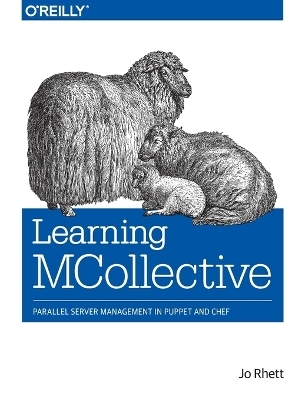
Learning MCollective
O'Reilly Media (Verlag)
978-1-4919-4567-4 (ISBN)
Learn how to build an entire installation by hand, know where every configuration file lives, and understand every configuration parameter and what it means. Whether you manage a small environment or one that’s immense in scale, this book shows you how to orchestrate specific actions faster and better than you do now.
- Tour MCollective’s architecture, backbone, transport, and security controls
- Configure MCollective components to match your production environment
- Create and use collectives to handle thousands of remote MCollective agents
- Use ActiveMQ Network of Brokers to resolve multi-site or redundancy requirements
- Learn how to use community-built client and agent plugins, with concrete examples
- Create your own server and client plugins to perform a variety of actions
- Learn recommended best practices for using MCollective
Jo Rhett is a network engineer and system administrator with more than 20 years of experience maintaining production CentOS/Red Hat, Debian, FreeBSD, Solaris and other Unix-based hosts and IP-based networks. He actively assists companies with IPv6 deployment. Jo has been using, promoting, and enhancing configuration management systems for over 20 years. He implemented the complete package management functionality in Cfengine v2, before switching to Puppet for the last three years.
Getting Started
Chapter 1Introduction
What Is MCollective?
Why Parallel Execution?
How MCollective Works
Why Use MCollective
How to Fail with MCollective
Time to Get Started
Chapter 2Installation
Requirements
Where to Install
Passwords and Keys
Puppet Labs Repository
Configuring ActiveMQ
Installing Servers
Creating a Client
Installing from Source
Testing Your Installation
Troubleshooting
Chapter 3Command-Line Client
Configuration File
Connector
Facts
Inventory
Discovery
Filters
Limits
Output
Classes
Bash Completion
Chapter 4Web Clients
Puppet Enterprise
mcomaster
Chapter 5Agent and Client Plugins
Connector Plugins
Installing Agents from Packages
Installing Agents from Source
Notify mcollectived
Disabling Agents
Using Client Plugins
Finding Community Plugins
Recommended Plugins
Chapter 6Maintenance
Time Sync
Keeping Sessions Alive
Activating Changes
Server Statistics
Logging
Monitoring Servers
Chapter 7Configuration Management
Puppet
Chef
Chapter 8Controlling Puppet Agent
Install the Puppet Agent
Checking Puppet Status
Controlling the Puppet Daemon
Invoking Ad Hoc Puppet Runs
Manipulating Puppet Resource Types
Chapter 9Waking the Chef
Install the Chef Agent
Checking Chef Status
Invoking Ad Hoc Chef Client Runs
Complex Installations
Chapter 10Middleware Configuration
Messaging Brokers
Network Security
IPv6 Dual-Stack Environments
ActiveMQ Config Structure
Detailed Configuration Review
ActiveMQ Clusters
Large-Scale Broker Configurations
Chapter 11Middleware Security
Anonymous TLS
CA-Verified TLS Servers
Validate keyStore and trustStore
CA-Verified TLS Clients
Conclusion
Chapter 12Creating Collectives
Deciding When to Create More
Collectives != Clustering
Configuration Traffic
Localizing Traffic
Limiting Access
Conclusion
Chapter 13MCollective Security
How Authentication Works
Pre-Shared Key Authentication
SSL Authentication
RSA Authentication AES Encryption
SSHKey Authentication
Authorization
Auditing
Conclusion
Chapter 14Challenges of Worldwide Parallelism
Custom Plugins
Chapter 15Building an Agent
SimpleRPC Framework
Start with a Baseline
Validate Input
Send Replies
Define an Agent DDL
Read Config Files
Install Your Agent
Testing the Agent
Chapter 16Extending the Agent
Executing Scripts
Executing Commands
Accessing Facts, Agents, and Classes
Results and Exceptions
Logging
Chapter 17Creating a Client Application
Baseline Client
Client Filters
Results and Exceptions
Install Your Client
Chapter 18Processing Multiple Actions
Chapter 19Making a Standalone Client
Baseline Client Program
Running Your Program
Chapter 20Creating Other Plugins
Authorization Plugins
Facts Plugins
Chapter 21Processing Registration Data
Registration Agent
Registration Collector
Registration and SSL Security
Chapter 22Collecting Responses
Create a Listener
Submit reply-to
Process Responses
Chapter 23Running MCollective Without Root
Chapter 24Downloading the Code
Putting It All Together
Chapter 25Use Best Practices
Make Use of Configuration Management
Choose the Best Discovery Method
Authorize and Audit Each Request
Chapter 26Grow Your Deployment
Consider the Strings Analogy
Utilize Support Resources
Read Blogs
| Erscheint lt. Verlag | 30.9.2014 |
|---|---|
| Verlagsort | Sebastopol |
| Sprache | englisch |
| Maße | 181 x 232 mm |
| Gewicht | 468 g |
| Einbandart | kartoniert |
| Themenwelt | Mathematik / Informatik ► Informatik ► Netzwerke |
| Informatik ► Weitere Themen ► Hardware | |
| Schlagworte | Chef • Netzwerk • Netzwerkadministration • Puppet • Server • Serveradministration |
| ISBN-10 | 1-4919-4567-2 / 1491945672 |
| ISBN-13 | 978-1-4919-4567-4 / 9781491945674 |
| Zustand | Neuware |
| Haben Sie eine Frage zum Produkt? |
aus dem Bereich


